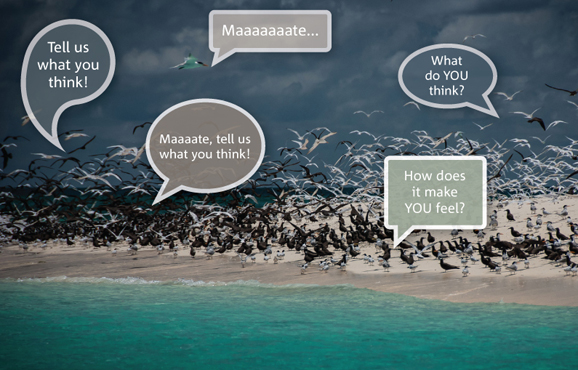A pink anemone fish in a magnificent anemone, Ribbon Reefs, Great Barrier Reef.
A pink anemone fish in a magnificent anemone, Ribbon Reefs, Great Barrier Reef. Just one of the 1,625 species of bony fish found in the reef.
Australia’s iconic Great Barrier Reef attracts nearly two million tourists every year and it runs for 2300km down the east coast – so big it can be seen from outer space.
But what does the Great Barrier Reef mean to you? Well, CSIRO wants to know!
In a study exploring how people interact with the reef, what they love about it and what they want to protect, CSIRO will be posing questions to 5000 people across Queensland to find out.
Discovering what people really think is important about the Great Barrier Reef will help shape how the region is managed in the future.
Locals, tourists and business operators from Cooktown to Bundaberg will be quizzed over the next two months and a snapshot of their opinions will be published by the end of the year.
We will be approaching people to complete the quick 15 minute survey in shopping centres, beaches and tourist hotspots. Tourism operators and commercial fishers working in the region will be interviewed over the telephone.
Tourists with underwater scooters at Vlasoff sand cay.
Tourists with underwater scooters at Vlasoff sand cay. Nearly two million tourists visit the Great Barrier Reef each year.
Amazing facts about the Great Barrier Reef:
- The reef runs for 2300km down the east coast of Australia – so big it can be seen from outer space
- The United Nations Educational, Scientific and Cultural Organisation (UNESCO) listed the Great Barrier Reef as a World Heritage Site in 1981
- The Reef is home to the world’s largest collection of coral reefs, with 400 types of coral, 1625 species of bony fish and 3000 types of mollusc
- Within the Great Barrier Reef World Heritage Area (348,000 square kilometres) there are almost 3000 individual reefs of varying sizes and shapes, and over 900 islands
- About ten thousand ships travel through the reef area every year
- Commercial fishing is the fifth largest primary industry by value in Queensland, with a value of about $360 million each year
- More than 70 Aboriginal and Torres Strait Islander Traditional Owner clan groups along the east coast of Queensland assert Native Title rights, interests and responsibilities in the Great Barrier Reef Marine Park.*
Sooty and crested terns nesting on Taylor sand cay (with eggs and chicks) – just two of the hundreds of different species of birds that have been found across the Great Barrier Reef.
Find out more about our social research on the Great Barrier Reef:
- Understanding our perceptions about the Great Barrier Reef
- Balancing coastal use and community values with management options
*Facts thanks to www.unesco.org, www.reef.crc.org.au [12 June 2013] and the Great Barrier Reef Marine Park Authority (GBRMPA).





22nd June 2013 at 11:51 am
Have you considered setting up an online survey, for the people you can’t reach in shopping centres and tourist hotspots?
25th June 2013 at 9:05 am
Hi Samantha,
We did consider online surveys, but decided that face-to-face interviews were more appropriate because this would ensure that respondents were selected as randomly as possible. An online survey would only target people with an internet connection, or those who have a strong opinion about the reef which could bias the results.
22nd June 2013 at 9:21 am
A precious wonder of the world. Should be protected by all humankind.